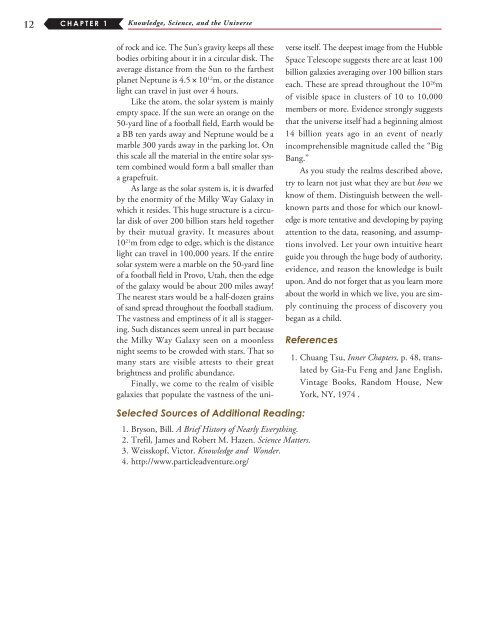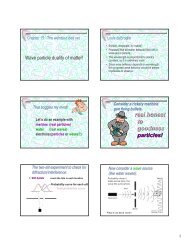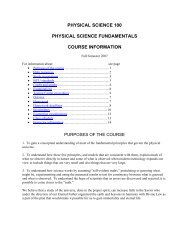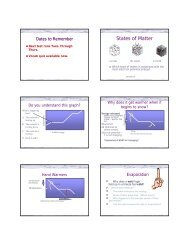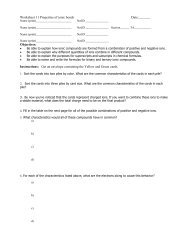knowledge, science, and the universe chapter 1 - Physical Science ...
knowledge, science, and the universe chapter 1 - Physical Science ...
knowledge, science, and the universe chapter 1 - Physical Science ...
You also want an ePaper? Increase the reach of your titles
YUMPU automatically turns print PDFs into web optimized ePapers that Google loves.
12<br />
C h A p T E R 1<br />
Knowledge, <strong>Science</strong>, <strong>and</strong> <strong>the</strong> Universe<br />
of rock <strong>and</strong> ice. The Sun’s gravity keeps all <strong>the</strong>se<br />
bodies orbiting about it in a circular disk. The<br />
average distance from <strong>the</strong> Sun to <strong>the</strong> far<strong>the</strong>st<br />
planet Neptune is 4.5 ¥ 10 12 m, or <strong>the</strong> distance<br />
light can travel in just over 4 hours.<br />
Like <strong>the</strong> atom, <strong>the</strong> solar system is mainly<br />
empty space. If <strong>the</strong> sun were an orange on <strong>the</strong><br />
50-yard line of a football field, Earth would be<br />
a BB ten yards away <strong>and</strong> Neptune would be a<br />
marble 300 yards away in <strong>the</strong> parking lot. On<br />
this scale all <strong>the</strong> material in <strong>the</strong> entire solar system<br />
combined would form a ball smaller than<br />
a grapefruit.<br />
As large as <strong>the</strong> solar system is, it is dwarfed<br />
by <strong>the</strong> enormity of <strong>the</strong> Milky Way Galaxy in<br />
which it resides. This huge structure is a circular<br />
disk of over 200 billion stars held toge<strong>the</strong>r<br />
by <strong>the</strong>ir mutual gravity. It measures about<br />
10 21 m from edge to edge, which is <strong>the</strong> distance<br />
light can travel in 100,000 years. If <strong>the</strong> entire<br />
solar system were a marble on <strong>the</strong> 50-yard line<br />
of a football field in Provo, Utah, <strong>the</strong>n <strong>the</strong> edge<br />
of <strong>the</strong> galaxy would be about 200 miles away!<br />
The nearest stars would be a half- dozen grains<br />
of s<strong>and</strong> spread throughout <strong>the</strong> football stadium.<br />
The vastness <strong>and</strong> emptiness of it all is staggering.<br />
Such distances seem unreal in part because<br />
<strong>the</strong> Milky Way Galaxy seen on a moonless<br />
night seems to be crowded with stars. That so<br />
many stars are visible attests to <strong>the</strong>ir great<br />
brightness <strong>and</strong> prolific abundance.<br />
Finally, we come to <strong>the</strong> realm of visible<br />
galaxies that populate <strong>the</strong> vastness of <strong>the</strong> <strong>universe</strong><br />
itself. The deepest image from <strong>the</strong> Hubble<br />
Space Telescope suggests <strong>the</strong>re are at least 100<br />
billion galaxies averaging over 100 billion stars<br />
each. These are spread throughout <strong>the</strong> 10 26 m<br />
of visible space in clusters of 10 to 10,000<br />
members or more. Evidence strongly suggests<br />
that <strong>the</strong> <strong>universe</strong> itself had a beginning almost<br />
14 billion years ago in an event of nearly<br />
incomprehen sible magnitude called <strong>the</strong> “Big<br />
Bang.”<br />
As you study <strong>the</strong> realms described above,<br />
try to learn not just what <strong>the</strong>y are but how we<br />
know of <strong>the</strong>m. Distinguish between <strong>the</strong> wellknown<br />
parts <strong>and</strong> those for which our <strong>knowledge</strong><br />
is more tentative <strong>and</strong> developing by paying<br />
attention to <strong>the</strong> data, reasoning, <strong>and</strong> assumptions<br />
involved. Let your own intuitive heart<br />
guide you through <strong>the</strong> huge body of authority,<br />
evidence, <strong>and</strong> reason <strong>the</strong> <strong>knowledge</strong> is built<br />
upon. And do not forget that as you learn more<br />
about <strong>the</strong> world in which we live, you are simply<br />
continuing <strong>the</strong> process of discovery you<br />
began as a child.<br />
References<br />
1. Chuang Tsu, Inner Chapters, p. 48, translated<br />
by Gia-Fu Feng <strong>and</strong> Jane English,<br />
Vintage Books, R<strong>and</strong>om House, New<br />
York, NY, 1974 .<br />
Selected Sources of Additional Reading:<br />
1. Bryson, Bill. A Brief History of Nearly Everything.<br />
2. Trefil, James <strong>and</strong> Robert M. Hazen. <strong>Science</strong> Matters.<br />
3. Weisskopf, Victor. Knowledge <strong>and</strong> Wonder.<br />
4. http://www.particleadventure.org/


